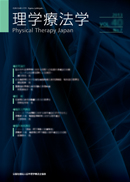
- |<
- <
- 1
- >
- >|
-
Jun TAKIHARA, Yasutsugu ASAKAWA2023 Volume 50 Issue 1 Pages 1-8
Published: February 20, 2023
Released on J-STAGE: February 20, 2023
Advance online publication: January 31, 2023JOURNAL FREE ACCESSObjective: To clarify the factors that affect activity and walking speed in patients after opening wedge high tibial osteotomy (OWHTO).
Methods: We included 58 patients, 60 limbs who had been treated with OWHTO for 6 months. We evaluated walking speed, knee extension/flexion range of motion, knee extension muscle strength, and knee symptoms and activity using the Japanese version of the Knee Society Score. The effects on activity and walking speed were examined using multiple regression analysis (forced entry method) that included patient background factors such as sex, age, Kellgren–Lawrence classification, and body mass index.
Results: Knee extensor muscle strength and knee symptoms were selected as independent variables to determine activity, and knee extension muscle strength and sex were selected as independent variables to determine walking speed.
Conclusion: We found that knee extension muscle strength affects both activity and walking speed, knee symptoms affect activity, and sex affects walking speed.
View full abstractDownload PDF (593K)
-
Ryotaro WAKI, Yasuaki KUSUMOTO, Katsuya TAKAHASHI, Eri KATO2023 Volume 50 Issue 1 Pages 9-16
Published: February 20, 2023
Released on J-STAGE: February 20, 2023
Advance online publication: February 13, 2023JOURNAL FREE ACCESSObjective: This study aimed to clarify the changes in gait patterns before and after hip muscle release surgery in Japan using the Edinburgh Visual Gait Score (EVGS).
Methods: A total of 16 patients with cerebral palsy with Gross Motor Function Classification System (GMFCS) levels I and II who underwent selective hip muscle release surgery were selected. The EVGS was assessed before and after surgery, and the total score, score for each joint, and score for each item were examined by corresponding t-test and χ2 test.
Results: The total EVGS score preoperatively was 28.9±7.4 points, while that postoperatively was 18.5±8.0 points, showing a significant improvement postoperatively compared to that of preoperatively. All joints showed significant changes in each joint.
Conclusion: In cerebral palsy patients with GMFCS levels I and II, physiotherapy intervention in the early postoperative period after hip arthroplasty can improve the gait pattern at 9 weeks postoperatively. In addition, when providing physical therapy intervention after hip arthroplasty, it is necessary to consider changes in the overall gait pattern, rather than focusing only on the hip joint.
View full abstractDownload PDF (414K)
-
Tatsuro Inoue2023 Volume 50 Issue 1 Pages 17-23
Published: February 20, 2023
Released on J-STAGE: February 20, 2023
JOURNAL FREE ACCESSDownload PDF (2655K)
-
Yasutaka Umayahara2023 Volume 50 Issue 1 Pages 24-29
Published: February 20, 2023
Released on J-STAGE: February 20, 2023
JOURNAL FREE ACCESSDownload PDF (1353K)
-
2023 Volume 50 Issue 1 Pages 31
Published: February 20, 2023
Released on J-STAGE: February 20, 2023
JOURNAL FREE ACCESSDownload PDF (269K)
- |<
- <
- 1
- >
- >|